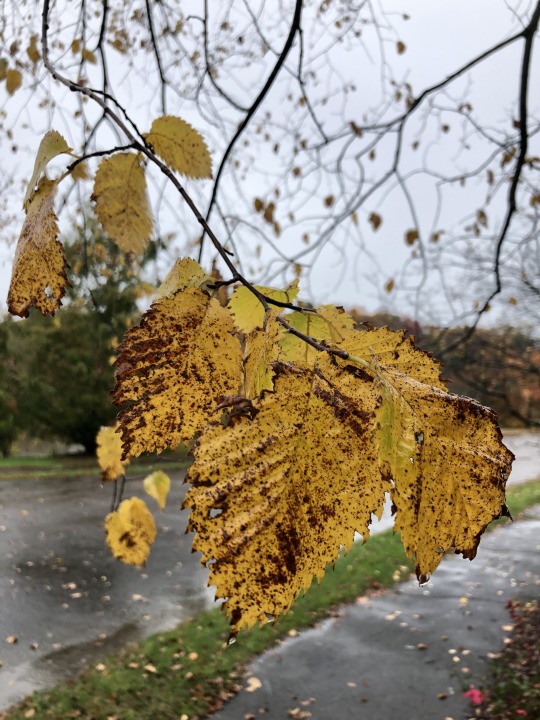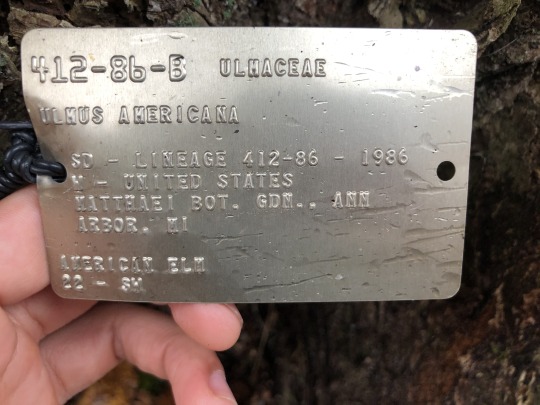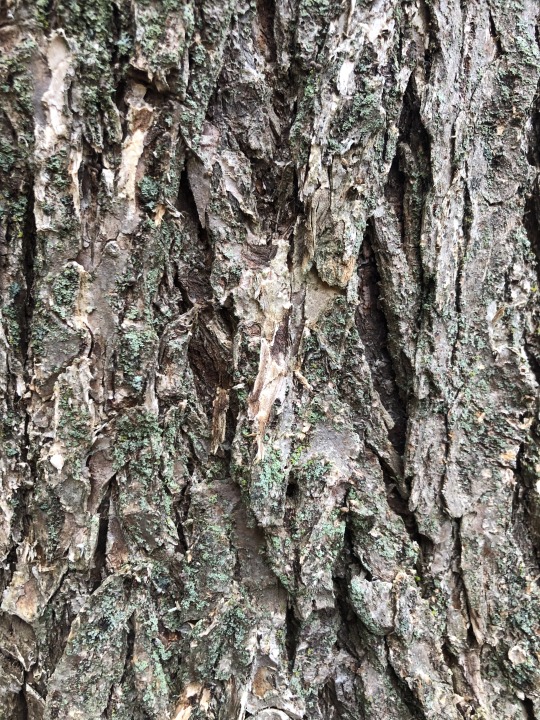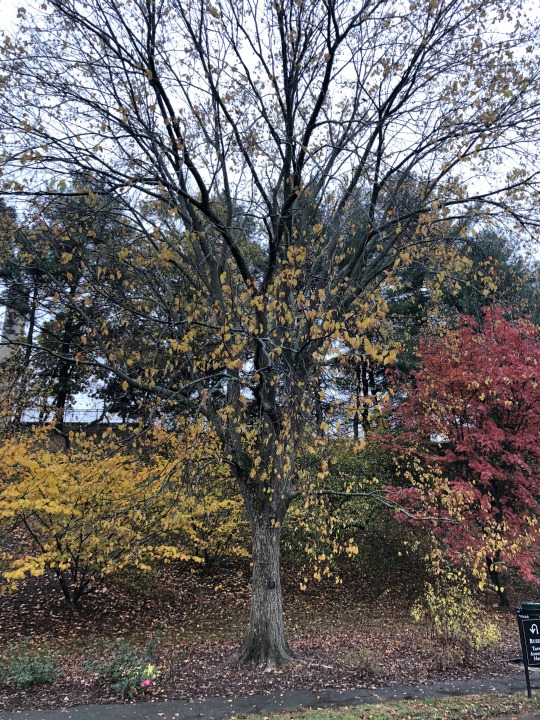#floodtolerant
Explore tagged Tumblr posts
Photo




Ulmus americana (American Elm)
Plant community: Red Maple Swamp
Native status: Native to Eastern North America
Mature size (height & width):
Height: 60-80 ft
Width: 40-70 ft
Habitat/ Tolerances
Wet land habitat
Drought tolerant
Flood tolerant
Heat tolerant
Wind tolerant
Pollution tolerant
Tolerant to urban conditions
High Susceptibility to Disease (Dutch Elm Disease)
Eco-indicator:
Hardiness zone: 2-9
Leaf color: Dark green leaves in the summer which change to a yellow in the fall
Flower color / bloom time: Reddish-green blooms which come out between March and April
Response to Climate Change:
Despite susceptibility to Dutch Elm disease, climate change is predicted to make temperature conditions more suitable for Elms along the east coast.
Population and biomass expected to increase in suitable habitat with application of disease resistant species
Tolerance to heat and drought make the species adaptable to temperature rise
Potential Climate applications:
If we can develop reliable disease resistant species, American Elms could be a powerful climate change adaption tool.
With its variety of tolerances, resistance to drought, flooding, and urban pollution, The American Elm tree could serve as effective flooding buffers and carbon sinks, “Studies have shown, that a single large American elm, located on the southern side of a home, can intercept 2,384 gallons of storm water, conserve 107 kWh of energy, and sequester 518 pounds of CO2 annually”.
However, the largest obstacle is it’s susceptibility to Dutch Elm disease. Old growth Elms once dominated American floodplain forests and city scapes, but after the introduction of Dutch Elm Disease in the 1930s, Elm populations were devastated (millions lost). Now it is very rare to find Elms as large as they used to be. In order to save the species, researchers are monitoring natural populations, working to develop disease resistant species, and reintroducing these resistant strains to the wild. Many cultivars of the Elm have shown resistance to the disease and could be planted for their climate adaption benefits.
Carbon sink
Erosion control
Climate adaptability rank: 8
http://www.g-wow.org/App_Uploads_Docs/Submissions/2016%20Wisconsin-WesternUP%20Climate%20Change%20Projections%20for%20Individual%20Tree%20Species.pdf
https://blog.nature.org/science/2017/08/09/quest-restore-american-elms-nearing-finish-line/
http://www.missouribotanicalgarden.org/PlantFinder/PlantFinderDetails.aspx?kempercode=a922
https://www.mortonarb.org/trees-plants/tree-plant-descriptions/american-elm
#arnoldarboretum#redmapleswamp#droughtolerant#floodtolerant#heattolerant#windtolerant#pollutiontolerant#urbantolerant#diseasevulnerable#superclimateplant#supercarbonsink#erosioncontrol#americanelm
0 notes
Photo

15th National Biotechnology Week Biotek:Makabagong Solusyon sa Kalusigan (Biotech: Modern Solution for Health) #nbw2019ph #irri #healthierrice #HighIronZincRice #GoldenRice #conventionalbreeding #salttolerant #floodtolerant #droughttolerant (at Senate of the Phillipines) https://www.instagram.com/p/B4_OdajD40g/?igshid=ufnizk64nbrs
#nbw2019ph#irri#healthierrice#highironzincrice#goldenrice#conventionalbreeding#salttolerant#floodtolerant#droughttolerant
0 notes
Photo


Sphagnum spp. (Sphagnum Moss)
Plant community: Red Maple Swamp
Native status:
Mature size (height & width):
Height: 2-5 inches
Width: grows in mats of varying sizes
Habitat/ Tolerances
Wetland habitat
Flood tolerant
Wet conditions
Eco-indicator:
Hardiness zone:
Leaf color: green
Flower color / bloom time: non-flowering
Response to Climate Change:
Peat land bog habitat is under threat by increasing temperatures and drought.
Destruction and draining of peatland habitat, often for agricultural purposes can result in a variety negative climate effects.
10% of global carbon emissions due to peatland draining
Increases risk of flooding a drought
Reduced water quality
Potential Climate applications:
Sphagnum moss bogs are super carbon sinks (0.37 gigatonnes a year)
More carbon sequestration than all other vegetation in the world combined
Natural flood buffer
Biodiversity preservation
Water filtration
A highly absorbent plant which can hold up to 26 times it’s own dry weight. Moss can help retain water during drier conditions. Dead and decaying sphagnum moss or peat is often harvest and used as a soil supplement to help sandy dry soil types hold moisture. It could be used to help plants grow in drier areas impacted by drought.
Sphagnum peat bogs are very important in terms of dealing with the impacts of climate change. They provide a variety of ecosystem services through their role in sequestering carbon, preserving bio diversity, and purifying water. Sphagnum peat bogs also regulate water flows minimizing the risk of flooding, drought and seawater intrusion. Members of the Paris Agreement on climate change are encouraged to include peatland restoration in their climate plans.
Climate adaption rank: 6
https://www.iucn.org/resources/issues-briefs/peatlands-and-climate-change
https://www.stockholmresilience.org/research/research-news/2019-02-05-bogged-down.html
https://www.gardeningknowhow.com/garden-how-to/soil-fertilizers/sphagnum-moss-vs-sphagnum-peat-moss.htm
http://www.bio.brandeis.edu/fieldbio/Survival/Pages/sphagnummoss.html
#redmapleswamp#floodtolerant#supercarbonsink#floodcontrol#erosioncontrol#superclimateplant#native#sphagnummoss
0 notes
Photo





Fraxinus pennsylvanica (Green Ash)
Plant community: Spontaneous Urban Growth
Native status: Native to North America
Mature size (height & width):
Height: 50 – 70 ft
Width: 35 – 50 ft
Habitat/ Tolerances:
Commonly found in low woods, floodplains and along streams, ponds and sloughs
Pollution tolerant
Pest vulnerable (Emerald Ash borer)
Salt tolerant
Drought tolerant
Flood tolerant
Poor drainage tolerant
Eco-indicator:
Hardiness zone: 3-9
Leaf color:
Dark green leaves in the summer. Leaves turn yellow or yellow green in the fall.
Flower color / bloom time:
Purple blooms which come out between April and May
Response to Climate Change:
Researchers predict that due to average temperature rise, shorter winters and a decrease in frequency of extreme cold in the Northeast the range of emerald ash borer infected areas will increase. The invasive species thrives in warmer climates and is often held back by extreme cold, but climate change impacts are improving conditions for the pest. The pest has already killed tens of millions of Green Ash trees. These changes in climate could lead to further habitat and population loss for the green ash.
Potential Climate applications:
The Green Ash has a variety of useful tolerances to flooding, drought, and pollution making it well equipped as an urban storm water tree and ready for the impacts of climate change. However, applications may be limited by the increased prevalence of the green ash borer which has devastating impacts on Green Ash populations.
Climate adaption rank: 1
Sources:
https://www.mortonarb.org/trees-plants/tree-plant-descriptions/green-ash-not-recommended
http://www.missouribotanicalgarden.org/PlantFinder/PlantFinderDetails.aspx?kempercode=a868
https://www.sciencedaily.com/releases/2018/05/180517113751.htm
#greenash#arnoldarboretum#pollutiontolerant#salttolerant#droughttolerant#floodtolerant#pestvulnerable#poordrainagetolerant#climatevulnerable
0 notes
Photo







Taxodium distichum (Baldcypress)
Plant community: Forest wetlands
Native status: Native to the Midwest US
Mature size (height & width):
Mature height: 50 - 70 ft
Mature width: 30 - 30 ft
Habitat/Tolerances:
Common in the Southern US, especially wetlands and coastal areas. Some of the worlds oldest trees which date back thousands of years (Oldest 2624 years).
Adaptable to wet, dry, and swampy soil types
Flood tolerant
Drought tolerant
Heat tolerant
Salt Intolerant
Tolerant to urban environments
Shoreline stabilizer
Eco-indicator:
Hardiness zone: 4-11
Leaf color:
The Baldcypress has short needles which grow in pairs along the tree’s branchlets.
Spring: yellow and green
Fall: Reddish or orangish-brown
Flower color / bloom time: Inconspicuous flowers
Response to Climate Change:
Baldcypress trees are a highly resilient species which can adapt to wet and dry conditions, drought as well as withstand flooding. Many grow in constantly wet conditions along flood plains near rivers. In wet conditions the tree will develop “cypress knees” where it’s roots will stick up out of the ground. Serve as major carbon sinks. At the moment scientists are unsure how climate change will impact bald cypress populations, but fear a mass mortality of bald cypress old forest will result in a huge uptake of CO2 into the atmosphere. Studies have shown that warming and drying of the climate will likely result in the loss of southern populations of Baldcypress swamps. Populations that are most vulnerable are in Texas and south Florida.
Predicted population decline in southern regions
Potential Climate applications:
With such adaptable traits and tolerances, and native shoreline habitat the Baldcypress has a lot of application potential to adapt to climate impacts. One of its cultivars, the Shawnee Brave bald cypress is ideal for urban spaces and could be used for urban climate adaptation projects. A it is a very effective tree to reduce erosion, and a top carbon sink.
Climate indicator:
Growing for such long periods of time researchers have studied bald cypress tree rings in the Black River reserve to pinpoint major climate events of the past, including a two year drought in 1587 which was one of the worst in over 1000 years. Which may have correlated with the disappearance of the English Roanoke colony in North Carolina. Rings have also been shown to have withstood another 7 year drought prior.
Sources:
https://www.arborday.org/trees/treeguide/treedetail.cfm?itemID=787
https://www.mortonarb.org/trees-plants/tree-plant-descriptions/bald-cypress
https://www.ncbi.nlm.nih.gov/pmc/articles/PMC5502657/
https://www.smithsonianmag.com/science-nature/north-carolina-bald-cypresses-among-worlds-oldest-trees-180972134/
https://pubs.usgs.gov/of/2006/1269/pdf/of06-1269_508.pdf
https://www.tlake.com/blog/the-8-best-trees-for-erosion-control-in-middle-georgia
#arnold arboretum#bald cypress#cypress knees#climate resilient#needles#conifer#urbanuse#shorelinestabilizer#supercarbonsink#floodtolerant#droughttolerant#heattolerant#saltintolerant#populationdecline#climateindicator#superclimateplant
0 notes
Photo



Catalpa speciosa (Hardy Catalpa)
Plant community:
Native status: Native to the United States
Mature size (height & width):
Height: 40-70 ft
Width: 20-50 ft
Habitat/ Tolerances:
Drought tolerant
Air pollution tolerant
Flood tolerant
Tolerant of urban conditions
Salt tolerant
Eco-indicator:
Hardiness zone: 4-8
Leaf color: Green leaves which turn yellowish brown in the Fall
Flower color / bloom time: White, purple, and yellow blooms which come out in May and June
Response to Climate Change:
The Catalpa is a highly adaptable tree its tolerances drought and flooding make it resistant to a lot of the effects of climate change.
Suitable habitat increase
Potential Climate applications:
The Catalpa is already used in the urban setting for its aesthetic and shading purposes. Its tolerances to flooding, and drought will make it an ideal long term street tree.
Climate adaption rank: 7
Sources:
http://www.g-wow.org/App_Uploads_Docs/Submissions/2016%20Wisconsin-WesternUP%20Climate%20Change%20Projections%20for%20Individual%20Tree%20Species.pdf
https://www.mortonarb.org/trees-plants/tree-plant-descriptions/northern-catalpa
https://www.missouribotanicalgarden.org/PlantFinder/PlantFinderDetails.aspx?kempercode=a856
#arnoldarboretum#hardycatalpa#habitatincrease#droughttolerant#pollutiontolerant#floodtolerant#urbantolerant#salttolerant#native#superclimateplant
0 notes
Photo




Malus sargentii (Sargent Crabapple)
Plant community:
Native status: Native to Japan
Mature size (height & width):
Height: 6-8 ft
Width: 9-15 ft
Habitat/ Tolerances
Pollution tolerant
Flood tolerant
Drought tolerant
Disease resistant
Adapts to a wide range of soils
Eco-indicator:
Hardiness zone: 4-7
Leaf color: Dark green leaves
Flower color / bloom time: White flowers which bloom in April
Climate adaption rank: 5
Sources:
https://www.mortonarb.org/trees-plants/tree-plant-descriptions/sargent%E2%80%99s-crabapple
http://www.missouribotanicalgarden.org/PlantFinder/PlantFinderDetails.aspx?kempercode=q240
#sargentcrabapple#nonnative#arnoldarboretum#pollutiontolerant#floodtolerant#droughttolerant#diseaseresistant#climateready
0 notes
Photo



Celastrus scandens (American Bittersweet)
Plant community:
Native status: Native to North America
Mature size (height & width):
Height: 15-20 ft
Width: 30-60 ft
Habitat/ Tolerances:
Flood tolerant
Salt tolerant
Drought tolerant
Hardiness zone: 3-8
Leaf color: Yellow fall color
Flower color / bloom time:
Greenish-white to yellow blooms which come out between May and June
Response to Climate Change:
The American Bittersweet is already adaptable to a variety of climate conditions due to it’s drought and flooding tolerances.
Potential Climate applications:
When planted with existing shrub plantings the American Bittersweet can help reinforce erosion control.
Erosion control
Climate adaption rank: 5
Sources:
https://plants.usda.gov/factsheet/pdf/fs_cesc.pdf
http://www.missouribotanicalgarden.org/PlantFinder/PlantFinderDetails.aspx?kempercode=a151
https://www.mortonarb.org/trees-plants/tree-plant-descriptions/american-bittersweet
#americanbittersweet#arnoldarboretum#floodtolerant#salttolerant#droughttolerant#climateready#native#erosioncontrol
0 notes
Photo





Acer rubrum (Red Maple)
Plant community: Red Maple Swamp
Native status: Native to Eastern and central North America
Mature size (height & width):
Height: 40-70 ft
Width: 30-50 ft
Habitat/ Tolerances
Commonly occurs in wet bottom land, river flood plains and wet woods
Tolerant of urban conditions
Pollution tolerant
Wetland habitat
Flood tolerant
Tolerant of dry conditions
Salt intolerant
Eco-indicator:
Hardiness zone: 3-9
Leaf color: Dark green leaves which turn red, yellow and orange in the fall
Flower color / bloom time: Red or yellow blooms which come out in May and April
Response to Climate Change:
Under 20% of habitat expected change in population and biomass (minimal change)
Slight decrease in population (not as severe as Sugar Maple)
Slight Northern migration
Likely to move to higher elevation
Naturally found in wetland and floodplain habitats, areas are likely to become drier. These conditions are likely to impact Red Maples very minimally due to tolerances.
Potential Climate applications:
Red Maples are very adaptable trees and are likely to continue to thrive even with drier conditions and higher temperatures. They are already commonly used in an urban setting, but would be a strong choice for future projects due to their tolerances to drier conditions, flooding pollution and urban conditions.
Climate adaption score: 6
Sources:
https://www.hrwc.org/wp-content/uploads/Acer_rubrum.pdf
http://www.g-wow.org/App_Uploads_Docs/Submissions/2016%20Wisconsin-WesternUP%20Climate%20Change%20Projections%20for%20Individual%20Tree%20Species.pdf
https://www.missouribotanicalgarden.org/PlantFinder/PlantFinderDetails.aspx?kempercode=j170
https://www.mortonarb.org/trees-plants/tree-plant-descriptions/red-maple
#redmaple#arnoldarboretum#redmapleswamp#urbantolerant#pollutiontolerant#floodtolerant#saltintolerant#migrantnorth#superclimateplant
0 notes
Photo



Sambucus canadensis (American Elder)
Plant community:
Native status: Native to North America
Mature size (height & width):
Height: 5 - 12 ft
Width: 5 – 12 ft
Habitat/ Tolerances:
Erosion tolerant
Heat tolerant
Drought tolerant
Flood tolerant
Eco-indicator:
Hardiness zone: 3-9
Leaf color: Dark green leaves in the summer which turn yellow-green in the fall
Flower color / bloom time: White blooms which come out between June and July
Response to Climate Change:
American Elderberries have been shown to be extremely hardy in face of drought, making them highly adaptable to areas that will be affected by warmer temperatures and decreased precipitation.
Potential Climate applications:
Farmers in California have begun experimenting with growing elderberries in response to current drought conditions impacting the industry. A less water intensive and climate friendly plant Elderberries are characterized as on of, “many hardy ancient…crops that may be poised to a make a twenty-first century comeback”.
The California native elderberry grows extremely well in drought conditions. After a couple of years of growth you can completely remove irrigation and the plant will continue to produce large harvests of berries. The berries themselves are healthy for you, have multiple applications in different products and do not require additional water and fertilizer. Current studies are looking to develop better growing practices, increased nutritional research and boost consumer interest. The University of Vermont has already developed a user-friendly guide which instructs farmers on how to grow and utilize elderberries for profit in the Northeast.
Climate adaption rank: 7
Sources:
https://thebulletin.org/2019/10/a-food-to-farm-as-climate-changes-elderberries/
https://www.missouribotanicalgarden.org/PlantFinder/PlantFinderDetails.aspx?kempercode=f470
https://www.mortonarb.org/trees-plants/tree-plant-descriptions/common-elderberry-0
https://www.uvm.edu/sites/default/files/media/ElderberryGuideComplete.pdf
#arnoldarboretum#native#heattolerant#floodtolerant#droughtolerant#superclimateplant#americanelderberry
0 notes
Photo



Llex verticillata (Winterberry)
Plant community: Red Maple Swamp
Native status: Native to the Eastern United States
Mature size (height & width):
Height: 3-12 ft
Width: 3-12 ft
Habitat/ Tolerances
Typically occur in swamps, damp thickets, low woods and along ponds and streams
Wetland habitat
Pollution tolerant
Erosion tolerant
Flood tolerant
Salt Tolerant
Eco-indicator:
Hardiness zone:3-9
Leaf color: Dark green leaves in the summer which turn yellow green in the fall
Flower color / bloom time: Greenish-white blooms which come out between June and July
Response to Climate Change:
Limited studies on winter berry and climate response
Potential Climate applications:
Plant could be used for its erosion control potential due to it’s natural occurrence in wetlands and tolerances to salt and flooding.
Climate adaption rank: 5
Sources:
https://www.mortonarb.org/trees-plants/tree-plant-descriptions/common-winterberry
https://www.missouribotanicalgarden.org/PlantFinder/PlantFinderDetails.aspx?kempercode=d440
#redmapleswamp#pollutiontolerant#erosiontolerant#floodtolerant#salttolerant#erosioncontrol#climateready#winterberry
0 notes
Photo






Sycamore Antracnose (Sycamore)
Plant community:
Native status: Native to the Southeastern United States
Mature size (height & width):
Height: 75 – 100 ft
Width: 75 -100 ft
Habitat/ Tolerances:
Common along rivers and streams
Flood tolerant
Salt tolerant
Poor drainage tolerant
Pollution tolerant
Tolerant of urban conditions
Disease vulnerable
Eco-indicator:
Hardiness zone: 4-9
Leaf color: Bright green in the summer. Leaves turn brown in the fall
Flower color / bloom time: Yellow male flowers and red female flowers come out in April
Response to Climate Change:
New habitat
Slower growth linked to dryer conditions and drought
Potential Climate applications:
Could be an effective storm water tree due to tolerances to urban pollution, flooding, and salt. May be limited due to disease impacts of Sycamore anthracnose which causes damage to foliage, twigs and premature leaf drop.
Climate adaption rank: 5
Sources:
https://www.researchgate.net/publication/31077418_Effects_of_climate_and_management_history_on_the_distribution_and_growth_of_sycamore_Acer_pseudoplatanus_L_in_a_southern_British_woodland_in_comparison_to_native_competitors
https://www.mortonarb.org/trees-plants/tree-plant-descriptions/sycamore
http://www.missouribotanicalgarden.org/PlantFinder/PlantFinderDetails.aspx?kempercode=a891
https://forestadaptation.org/sites/default/files/Northwoods_tree_species_Driftless_area.pdf
http://www.g-wow.org/App_Uploads_Docs/Submissions/2016%20Wisconsin-WesternUP%20Climate%20Change%20Projections%20for%20Individual%20Tree%20Species.pdf
#arnoldarboretum#native#floodtolerant#salttolerant#poordrainagetolerant#pollutiontolerant#urbantolerant#diseasevulnerable#newhabitat#erosioncontrol#climateready#sycamore
0 notes
Photo




Quercus palustris (Pin Oak)
Plant community: Spontaneous Urban Growth
Native status: Native to Northeastern United States
Mature size (height & width):
Height: 50-70 ft
Width: 40-60 ft
Habitat/ Tolerances
Native to low-land wet areas
Drought intolerant
Fire tolerant
Moderately flood tolerant
Intolerant of Alkaline soils (Chlorosis)
Pest vulnerable
Disease vulnerable
Eco-indicator:
Hardiness zone: 4-8
Leaf color: Medium green in summer, changing to russet or red in the fall
Flower color / bloom time: Yellowish-green blooms which come out in April
Response to Climate Change:
New habitat
Expected population increase
Northward migration
Potential Climate applications:
May be utilized for erosion control due to its natural occurrence in wetland areas.
Climate Adaption Rank: 4
https://forestadaptation.org/sites/default/files/NE_Northern_Species_final.pdf
https://www.missouribotanicalgarden.org/PlantFinder/PlantFinderDetails.aspx?kempercode=a904
https://www.mortonarb.org/trees-plants/tree-plant-descriptions/pin-oak
https://www.fs.fed.us/database/feis/plants/tree/quepal/all.html
#arnoldarboretum#spontaneousurbangrowth#native#droughtintolerant#fireadapted#floodtolerant#pestvulnerable#diseasevulnerable#newhabitat#populationincrease#migrantnorth#climateready#erosioncontrol#pinoak
0 notes
Photo





Salix Nigra (Black Willow)
Plant community: Black Willow flood plain
Native status: Native to North America
Mature size (height & width):
Height: 30-60 ft
Width: 30-60ft
Habitat/ Tolerances
Native to moist to wet soils of floodplains, stream/river banks, swamps, marshes, sloughs, and ponds
Erosion control
Wetland habitat
Flood tolerant
Salt tolerant
Drought intolerant
Poor drainage tolerant
Eco-indicator:
Hardiness zone: 4-9
Leaf color: Leaves are medium green and turn greenish-yellow in the autumn
Flower color / bloom time: Yellowish green blooms which come out march to mid April
Response to Climate Change:
Population and biomass expected to increase in suitable habitat
Northward migration
Potential Climate applications:
Shallow, spreading root system is good for stabilizing soils and makes the tree an effective selection for erosion control, and shoreline stabilization. Could be utilized to stabilize areas which will experience extreme erosion and flooding. However, the plant does not do well in hot drought effected areas.
Climate Adaption Score: 6
https://www.tlake.com/blog/the-8-best-trees-for-erosion-control-in-middle-georgia
http://www.g-wow.org/App_Uploads_Docs/Submissions/2016%20Wisconsin-WesternUP%20Climate%20Change%20Projections%20for%20Individual%20Tree%20Species.pdf
http://www.missouribotanicalgarden.org/PlantFinder/PlantFinderDetails.aspx?taxonid=286793&n=1
https://www.mortonarb.org/trees-plants/tree-plant-descriptions/black-willow
#arnoldarboretum#native#erosioncontrol#floodtolerant#salttolerant#droughtintolerant#poordrainagetolerant#populationincrease#migrantnorth#superclimateplant#blackwillow
0 notes
Photo





Pseudotsuga menziesii (Douglas Fir)
Plant community: The Cascades
Native status: Native to Southwestern British Columbia and western central California
Mature size (height & width):
Height: 40 - 80 ft
Width: 12 - 20 ft
Habitat/ Tolerances
The species is indigenous to coastal areas and up to 5500' in elevation in the mountains
Salt tolerant
Drought intolerant
Poor drainage intolerant
Flood intolerant
Heat intolerant
Fire adapted
Cold tolerant
Eco-indicator:
Hardiness zone: 4-6
Leaf color: Evergreen needles
Flower color / bloom time: Non-flowering
Response to Climate Change:
The tree does well in northern and northwestern climates but not in southern areas where dry weather and drought are common.
Northern migration
Potential Climate applications:
Due to its intolerance to heat, drought and flooding, the Douglas Fir would not have many climate adaption applications in areas enduring extreme heat, flooding or drought. However it is a very fire resistant tree and could be utilized in areas where climate induced fires are common.
Climate adaption rank: -3
https://www.missouribotanicalgarden.org/PlantFinder/PlantFinderDetails.aspx?kempercode=e890
https://www.mortonarb.org/trees-plants/tree-plant-descriptions/douglas-fir
https://www.fs.fed.us/database/feis/plants/tree/psemenm/all.html
#nonnative#arnoldarboretum#salttolerant#droughttolerant#poordrainagetolerant#floodtolerant#coldtolerant#fireadapted#climatevulnerable#douglasfir
0 notes
Photo





Acer Saccharinum (Silver Maple)
Plant community: Spontaneous Urban Growth
Native status: Native to Central United States
Mature size (height & width):
Height: 40-50 ft
Width: 40-50 ft
Habitat/ Tolerances:
Wetland habitat naturally occurs in floodplains
Drought tolerant
Pollution tolerant
Flood tolerant
Poor drainage tolerant
Salt intolerant
Eco-indicator:
Hardiness zone: 3-9
Leaf color: Leaves are green in the summer and turn yellow-green in the fall
Flower color / bloom time: Greenish Yellow blooms which come out in March
Response to Climate Change:
Population and biomass expected to increase in suitable habitat
Northward migration
Potential Climate applications:
Tolerances to drought, flooding and urban pollution make the silver maple an ideal tree for storm water control, erosion control, and cooling in an urban setting. Silver Maples have an extremely quick growth rate and hardy roots which could interfere with concrete and plumbing. The tree should be given adequate space to root if planted in a street setting.
Climate Adaption Rank: 6 https://arbordayblog.org/treeoftheweek/silver-maple-paradox/ http://www.g-wow.org/App_Uploads_Docs/Submissions/2016%20Wisconsin-WesternUP%20Climate%20Change%20Projections%20for%20Individual%20Tree%20Species.pdf https://forestadaptation.org/sites/default/files/Northwoods_tree_species_Driftless_area.pdf https://www.mortonarb.org/trees-plants/tree-plant-descriptions/silver-maple https://www.missouribotanicalgarden.org/PlantFinder/PlantFinderDetails.aspx?taxonid=261896&isprofile=0&
#arnoldarboretum#spontaneousurbangrowth#native#droughttolerant#pollutiontolerant#floodtolerant#poordrainagetolerant#saltintolerant#erosioncontrol#migrantnorth#newhabitat#superclimateplant#silvermaple
0 notes